Contents
More recently, dachas were presented to our citizens only as a place for growing potatoes and cucumbers. Everything has changed today. They try to decorate the personal plot and create on it not only beds, but also a place to relax. What place does the mixborder occupy on the site today, and how to make it yourself?
What is a mixborder
Even if you have never heard this name, you have probably seen this landing in a photo or on the sites of friends.
A mixborder is nothing more than a flower garden of several plants combined according to a certain principle. From English, this name is translated as “mix the border.” Very often on the Internet you can find ready-made schemes of such flower beds. They will decorate any site, if you choose the right combination of plants.
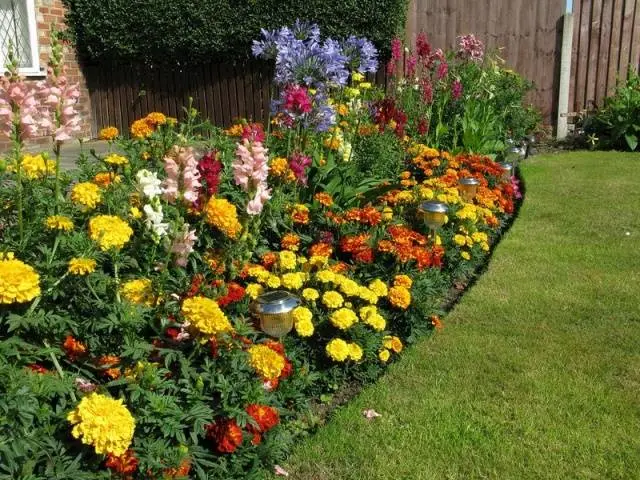
A mixborder is a flower bed, made up intentionally difficult, it combines:
- shrubs;
- annuals;
- perennial flowers;
- trees;
- herbs.
Not only the color scheme is important, but also the size of the plants, their species forms and flowering periods. Let’s figure out how to make a mixborder with your own hands so that the work does not turn into a routine.
Where to place the mixborder
Some summer residents and flower growers believe that choosing a place is the easiest thing at the stage of forming a complex flower bed. This is not true. The process does not begin with the purchase of seedlings, but with drawing up a detailed layout of both the mixborder itself and the plants for it.
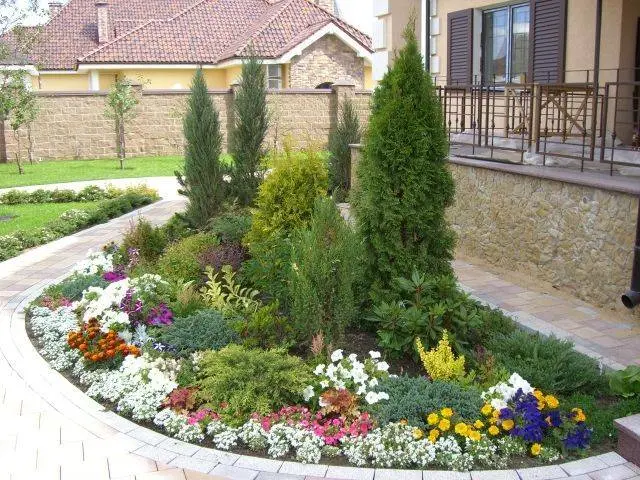
When choosing a place, the following nuances are important:
- where would you like to plant such a flower bed;
- whether the selected area is shaded and whether it is located under the scorching sun;
- which plants tolerate partial shade (shade or sun, depending on the choice);
- is there enough space for tall and sprawling trees and shrubs in the selected area.
Given these questions, it will be easy to move on to the next step: drawing up a diagram on paper. A complex flower bed can be located:
- along the tracks;
- in the middle of the lawn;
- at the outer edge of the site.
When choosing a place, you need to take into account that the mixborder is created to decorate the site, it must be visible. The form can be any, but most often they prefer shapeless flower beds. The volume of the mixborder also does not matter. If it is close to home, do not use honey plants for it, otherwise they will attract wasps and bees to the windows.
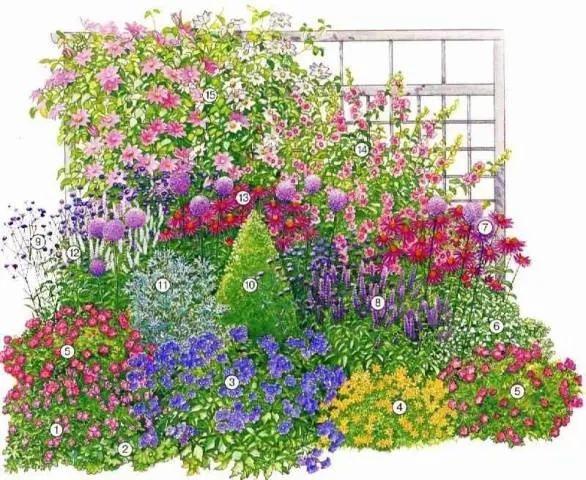
Selection of plants for a flower garden
The next step is the selection of plants and drawing up a schematic image. When choosing plants, you need to adhere to one principle: they will not bloom at the same time for a long time, so it is better to plant them so that they smoothly replace each other. A flower bed of continuous flowering is the best decoration for a personal plot.
The design of the flowerbed is based on the fact that low plants are brought to the fore (their height is no more than 40 centimeters), medium-sized ones are planted behind them (no more than 60 centimeters), tall ones (one meter or more) are relegated to the background. As tall plants, not only shrubs and trees can be used, but also climbing plants, for example, girlish grapes or clematis.
What plants should not be used in a mixborder? There are also rules for this:
- plants are selected according to the composition of the soil, humidity and protection from the wind;
- plants with rapidly growing rhizomes cannot be used in a flower bed;
- a place for each plant should be chosen with a benefit to it;
- it is impossible to combine plants with complex care (copiously watering one shrub, you can cause irreparable harm to the one next to it);
- do not ignore the greenery, the foliage will add splendor to the flower bed.
Only at first glance it seems that the plants in the mixborder are arranged randomly. In fact, the schemes of mixborders from perennials and annuals are carefully verified. The selected plants are similar to each other in terms of care requirements.
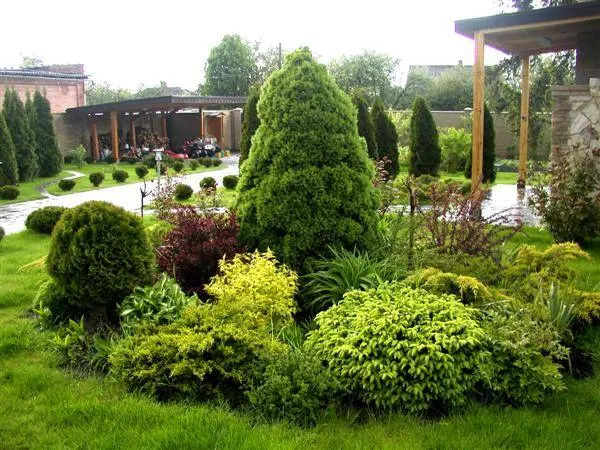
When choosing a scheme, be sure to give each plant as much space as it needs, otherwise you risk losing part of the plantings in the first year. If at the same time there are voids that are visible to the eye, they can be temporarily filled with annuals. When drawing up a scheme, pay attention to color combinations. The flower bed should simultaneously stand out on the site and be combined with it.
In winter, a mixborder of coniferous plants will not lose its appearance. It is best to use dwarf varieties for such a flower bed; plants with bright glossy leaves, such as rhododendron, perfectly complement them. It is easy to care for and blooms profusely.
Ready schemes
We present to the attention of readers several ready-made mixborder schemes for review. They can be used in full or in part.
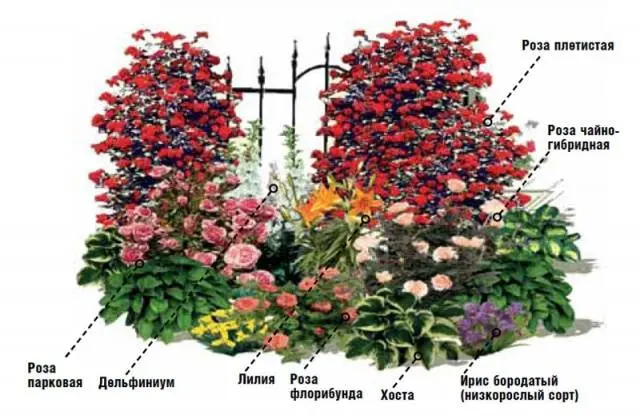
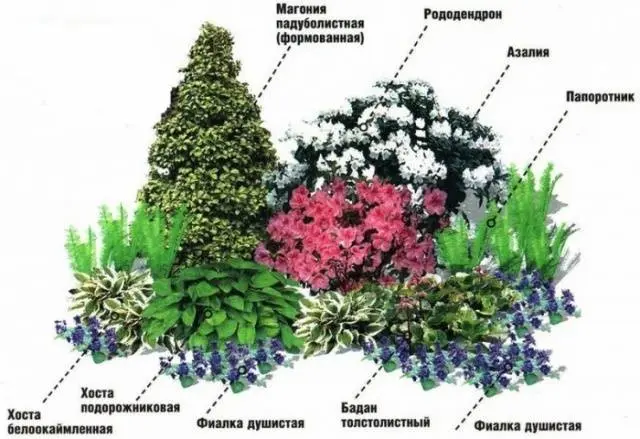
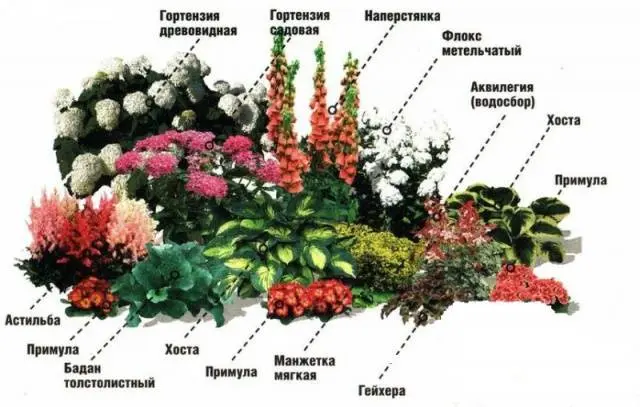
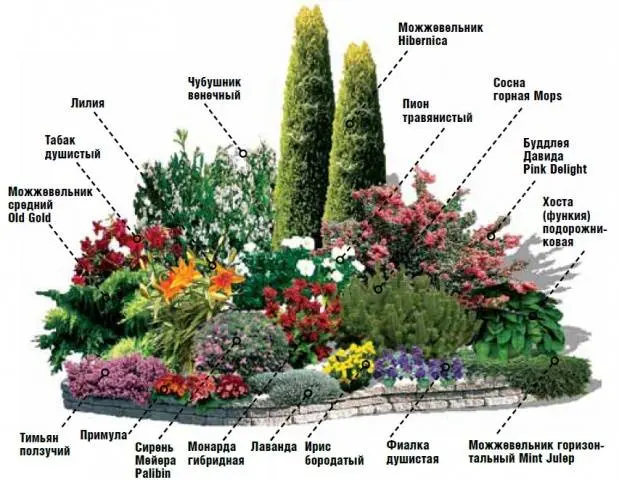
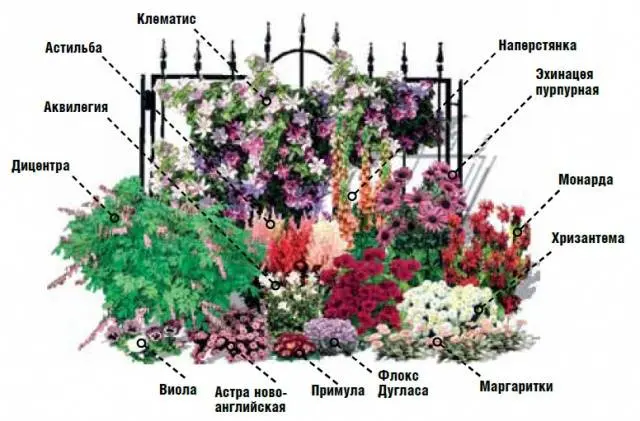
Please note that annuals are temporary, but a bright addition to the flower garden, every year you can plant new plants in their place or purchase the same ones. Green ferns, hosts, geyhers look spectacular in the flower garden.
When planning a large flower garden, you need to provide a small path in advance to make care easier.
The main types of mixborders
Consider the main types of mixborders that are popular today. The device of each of them may initially seem complicated, but it is not. After studying the material in detail, you can take up the matter yourself.
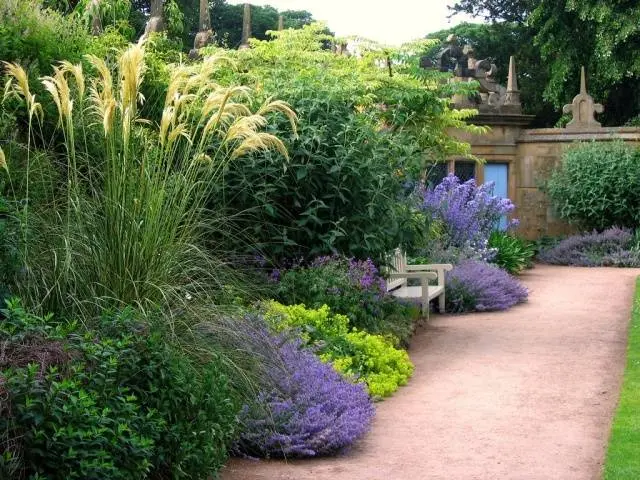
In english style
It is believed that in landscape design you can fantasize as you like. Mixborders in the English style will provide every grower with such an opportunity. They consist of both garden plants, familiar to our eyes, and meadow plants with a predominance of the latter, creating an atmosphere of closeness to nature on the site.
Vervain, rosemary, wormwood, bluebell, primrose, chamomile, sedum and, of course, park rose will be of great importance when arranging such a flower bed. The color scheme of roses is selected individually, they delight the eye with their flowering all year round. Of great importance is needles and other greens, which are necessarily included in the drawing. The main colors here will be green, pink, white and blue.
The landscape project in the English style is presented in the video:
On the shady side of the site
Not in all regions it is possible to create a flower garden from plants that love the sun. What about those flower growers who have a shaded place on the site? Create a bright flower garden from shade-loving plants.
In this case, you need to pay attention to such plants as Lawson’s cypress, some types of spruce, yew, juniper, adenium, barberry, many varieties of microbiota, rhododendrons, violets, tiarella. The main colors of the flower bed will be green, brick, red, pink and white.
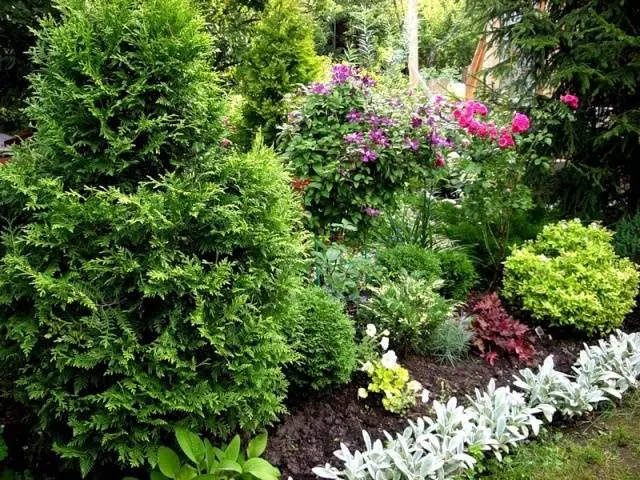
seasonal style
This type of mixborder is suitable for those who love variety and do not tolerate constancy. It is based on the principle of planting plants that bloom for no more than 1-2 years, and then are replaced by others. Summer residents who love the annual reorganization of the garden are becoming more common.
In this case, you need to pay attention to the following types of plants: blueberries, crocuses, chionodoxes, which will bloom in the initial period of spring. Then hyacinths, tulips and daffodils will sprout. Forget-me-not, daisy, primrose, violet will perfectly complement the flower garden. Once they have all faded, they can be removed and replaced with new plants. You can consider dahlias, marigolds, perennial sage, begonias.
As for color solutions, here the flight of fancy is completely unlimited. Moreover, it is this mixborder that will become the brightest.
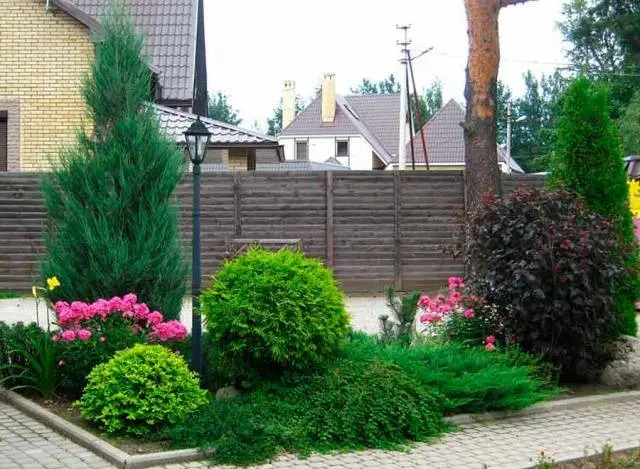
Creating a mixborder
So, having received a finished scheme from the Internet or creating it yourself, you can get to work. It is divided into several stages, the sequence must be observed.
- stage 1: selection of plants and their purchase;
- stage 2: planting a “skeleton”, which means low-growing trees and shrubs;
- stage 3: planting perennials;
- stage 4: replanting annuals and bulbs.
Let’s analyze each of the stages in more detail. Everyone can create a mixborder with their own hands.
When choosing plants, pay attention to their appearance. They must be healthy. You should not stop looking only at flowers, mixborders with decorative conifers look great. Shrubs are also good. Pay attention to arborvitae, junipers, willows, viburnum bushes, spruce, yew, hydrangea, which will delight the eye with flowers for a long time.
“Skeleton” plants are planted at a small distance from each other, they should look organic. Their task is to create the height and contour of the back of the flower bed. Focus on the fact that shrubs and stunted trees will soon grow. Many of them can be corrected with a haircut, but there are those that are not recommended to be cut, which means that it will be necessary to leave room for growth. As flowering shrubs, you can use: Meyer’s lilac, mock orange, spirea, magnolia, elderberry, deren, hibiscus.
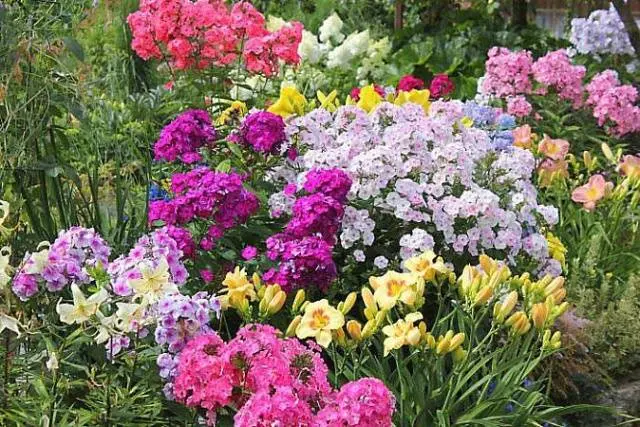
Moving on to the third stage, do not forget about the principle of tiering. Perennial mixborders, the photos of which are presented above, are compiled on the condition that the background is much higher than average. You can fill the flower garden with herbs. The most striking look sedge, ozhika, feather grass. You can also pay attention to wormwood, geranium, phlox and tunbergia.
As for annual plants and bulbs, they will give the flower garden a unique charm. The scheme should not include those bulbs that require annual digging. Muscari, crocuses and blueberries are best suited as them, they will be replaced a little later by tulips, primroses and daffodils. Annuals are also planted in small groups to create tiers and riots of color.
A brief guide to arranging a mixborder is presented in the video:
A mixborder of shrubs and perennials, generously diluted with annuals and bulbs, will decorate any backyard for many years. Having created your masterpiece once, you will enjoy it for many years!









